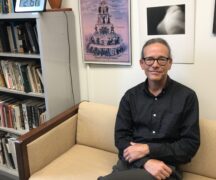By DAVID DUPONT
BG Independent News
On Friday, the Bowling Green State University Board of Trustees approved the naming of the porch on Shatzel Hall for a pioneer in ethnic studies at Robert Perry.
A two-time BGSU graduate, Perry was the founding director of the ethnic studies program in 1970, and founding chair when the program became a department nine years later. He also developed the university’s cultural diversity requirement, credited with being the first in the nation.
The veranda will be refurbished over the summer, said Chief Financial Officer Sheri Stoll in time for a reception in September for both Perry and his family including his son, Ravi Perry, who chairs the political science department at Howard University.
Trustee Linda Forte, a 1974 BGSU graduate, said that she found those courses “eye opening.” Perry was someone who “opened up the history of this the world and the country.”
National Trustee George Miller, a 1973 BGSU graduate, said he was privileged as a student be exposed to the Perry’s “eloquence and teaching style.”
Earlier in the day at the meeting of the board’s Committee on Diversity and Belonging, Miller referred to his time on campus from another angle. The graduation gap Black students and White students is the same as it was then though students as a whole are graduating at higher rates.
For the class that entered in 2016, just over 50 percent of White students graduated in four years while half of the Black students graduated in that time.
“Some of these challenges are not personal failings of the students, but because the system failed these students,” said Ana Brown, director of the Office of Multicultural Affairs.
Brown and Sarah Jurden, director of the Academic Investment in Mathematics and Science Program, co-chair the Student of Color Retention Committee. The committee presented a report Friday morning to trustees.
“If we, as an educational institution, truly believe that education is the fix,” Brown said, “then what can we do to close that gap, diminish some of those barriers to degree attainment and rectify some of the issues the students are facing?”
Assuring the success of these students is important, not just for them, but for the country, Brown said.
The U.S. faces a demographic shift. The number of traditional college age students is declining. The fastest growing populations are Latinx, Asian-Americans, and people of mixed race. The African-American share of the population is expected to remain constant.
“The population will be more racially and ethnically diverse than ever before,” Brown said.
But at this point Latinx and African-Americans are twice as likely to live in poverty.
When addressing the reasons students struggle, she said, it is important to look at “the whole person,” and their lives beyond the classroom. It is hard to succeed if you don’t have enough food, reliable transportation, child care if you are parents, or are exhausted from working.
“We have to have resources and partnerships at the ready,” Brown said.
Brown said they are also working with students throughout their time at BGSU on financial issues. Many think the FAFSA (Free Application for Federal Student Aid) is a “one and done,” and don’t realize they have to fill it out every year to qualify for financial aid. They also work with them to identify additional scholarship opportunities.
The university has to identify and reach out to students who are struggling academically
Jurden said they sent out emails to a targeted group of Black students who had not earned 60 credits by the end of their sophomore year. These emails, they were told, were opened at a higher rate than other university emails.
BGSU Chief Diversity and Belonging Officer Jennifer McCary said in these efforts it is important to work with academic advisors as well as with the coaches in the new life design program to try to keep students on track. But the outreach has to be proactive, not depending on the student seeking help.
Provost Joe Whitehead said that in the past many of these efforts to identify and assist these students have been “siloed.” Now “we need to highlight how we can collaborate and share data.”
Trustee Richard Ross noted that the issues predate students arriving on campus. The high schools from which many of these students graduate do not offer the College Credit Plus and Advance Placement courses that wealthier districts do.
“We’re trying to close those gaps,” McCary said.
The university is trying to work in various ways with high schools to help students get prepared, and is hoping to extend those efforts beyond Toledo schools to other urban districts in Ohio.
Whitehead also noted there’s been a change in approach toward students who come to campus less academically prepared. At one time it was thought it was best to ease them in with a reduced credit load. But it turns out they do better taking a full 15 credits, and they don’t end up having to stay on campus for extra semesters at additional expense.
McCary noted that there’s been intense attention paid to retaining students from their first to their second year. Those issues have to be consistently addressed throughout their academic careers. They need to be made aware that transferring will cost them money and time.
And those conversations must start early. The university’s 1910 courses are aimed at first year students. “We’re academic and career conversations right away with students,” Jurden said. “Not just how to design their BGSU experience, but how do you use your BGSU experience to leap frog” into a career.
Brown said that the university is working closely with the Black Alumni Council to help students find mentors and develop the networks needed to launch careers.
Trustee Geoff Radbill said there need to be more advisors and faculty of color in order to close these gaps. The faculty does not reflect the demographics of the student body. He said he’s heard from “numerous students of color” that sometimes its “hard to relate” to White faculty.
McCary said that diversifying the faculty will take a long time. Her office is working with deans and search committees on how to attract a diverse candidate pool.
Her office has worked to help develop training on creating inclusive classroom spaces and how to work with students of color.
They are also working with faculty to speak up to their peers when they witness bias or microaggressions including in the classroom.
As the discussion was ending, Whitehead noted he’s been dealing with these issues since 1991 in both predominately white institutions as well as at historically Black colleges and universities. “I’ve seen it from both sides,” he said.
“We have to look at this from a pipeline perspective. It’s a leaky pipeline. We have one segment of that pipeline in higher ed. So we have to think about it holistically. How do we change things systematically?”
Higher education, he said, produces the teachers and superintendents. “We drive a lot of the high school curricula. How we change the curricula so that students are better prepared?”
The demand for workers in the STEM disciplines is well known. But those courses are not popular with students in high school, so they when they get to college “they’re trying to catch up” and “that’s an impediment for success.”
Schools with fewer resources “don’t deliver the courses that students need to be successful coming in,” he said. “It’s got to be collective effort between higher ed and secondary school systems to make a difference.
Whitehead added that “we can’t wait to have the faculty reflect the diversity of the student population. We have to help every faculty member buy into this and make it a priority to help all students be successful. It has to be a concerted effort by all involved.”



